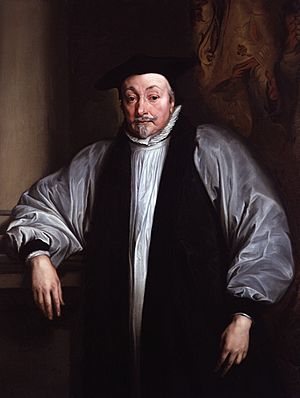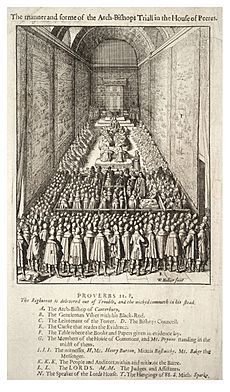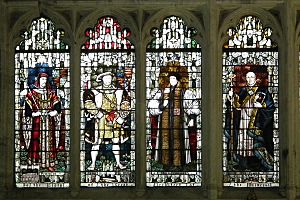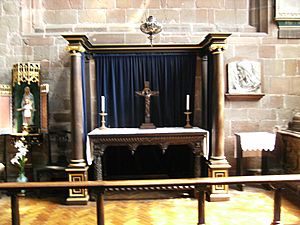William Laud facts for kids
Quick facts for kids The Most Reverend and Right Honourable William Laud |
|
|---|---|
| Archbishop of Canterbury | |

Portrait by Anthony van Dyck c. 1636
|
|
| Church | Church of England |
| Diocese | Canterbury |
| In Office | 1633–1645 |
| Predecessor | George Abbot |
| Successor | William Juxon |
| Orders | |
| Ordination | 5 April 1601 |
| Consecration | 18 November 1621 by George Montaigne |
| Personal details | |
| Born | 7 October 1573 Reading, Berkshire, England |
| Died | 10 January 1645 (aged 71) Tower Hill, London, England |
| Education | Reading School |
| Alma mater | St John's College, Oxford |
| Signature |  |
| Sainthood | |
| Feast day | 10 January |
| Venerated in | Anglican Communion |
William Laud (pronounced LAWD) was an important bishop in the Church of England. He was born on October 7, 1573, and died on January 10, 1645.
King Charles I chose Laud to be the Archbishop of Canterbury in 1633. This was a very powerful position in the church. Laud strongly supported the King's ideas for changing how the church was run.
He believed that bishops should lead the church. His ideas, sometimes called "Laudianism," focused on making church services more formal and uniform. Many of his ideas are similar to what are now called high church views.
Laud was accused of following "Arminianism," a set of beliefs that some people thought was too close to older church traditions before the Reformation. He was against Calvinism, another set of religious ideas. Because of his views, many Puritans saw him as a dangerous opponent. He also used a special court called the Star Chamber to punish people who disagreed with him, which made him very unpopular.
In 1640, the Parliament arrested Laud. He was executed in January 1645, during the First English Civil War.
Contents
William Laud's Early Life
Laud was born in Reading, Berkshire, England, on October 7, 1573. He was the only son of William Laud, who made and sold cloth. His mother, Lucy, was the sister of Sir William Webbe, a former Lord Mayor of London.
He went to Reading School and then to St John's College, Oxford in 1589. There, he studied with Thomas Holland. In 1593, he became a fellow of the college.
Laud earned his first degree in 1594 and a master's degree in 1598. He became a Doctor of Divinity in 1608. In 1604, he argued that churches needed bishops to be true churches. His teacher, Holland, publicly disagreed with him, saying Laud was causing trouble.
Laud became a deacon in 1601 and a priest in the same year.
Laud's Rise to Power
In 1611, Laud became the president of St John's College, Oxford. This happened after a big struggle, and King James I had to step in to help Laud get the job.
In 1616, Laud became the Dean of Gloucester. At Gloucester Cathedral, he started making changes to how church services were done. He moved the communion table to the east end of the church, which was different from the local custom. This upset the local bishop.
Laud had a powerful supporter named Richard Neile, who helped him get ahead. In 1621, Laud became the Bishop of St David's, a less important church position.
Laud also became a trusted friend of George Villiers, 1st Duke of Buckingham, a very important person in the King's court. Laud debated a Jesuit priest named John Percy in 1622. After this, Laud became the Duke's main religious advisor.
Under King Charles I
Laud quickly gained more power between 1626 and 1628. In 1626, he became the Bishop of Bath and Wells. In September of that year, he also became the Dean of the Chapel Royal, a special role at the King's court.
In 1633, Laud became the Archbishop of Canterbury, the most important church leader in England. He immediately changed the services in the Chapel Royal. He focused more on prayer than on preaching, which was what King Charles wanted.
Bishop of London and "Thorough"
In July 1628, Laud became the Bishop of London. This was a big step up in his church career. His supporters were often called "Laudians."
From 1629, King Charles I ruled without Parliament. Laud became a key part of this government, working closely with Thomas Wentworth, 1st Earl of Strafford. Laud believed in the King's power and did not like Parliament getting involved in royal decisions, especially about taxes.
When Wentworth went to Ireland in 1632, he and Laud wrote letters to each other. In these letters, they used the word "Thorough" to describe their plan. This meant they wanted to achieve the King's goals completely, without letting special interests or legal arguments get in the way.
Archbishop of Canterbury's Actions
Laud was almost 60 when he became archbishop. He had waited a long time for this role and was not willing to change his plans. He wanted to make the Church of England uniform, meaning everyone followed the same rules and practices.
He brought in his own people to check and approve books before they were published. One book, Histriomastix, which criticized plays and Christmas celebrations, caused a big scandal. Laud's strict control over what could be published became a major issue for Parliament.
Laud saw the Calvinist movement (which included the Puritans) as a threat to the power of bishops. But the Puritans felt threatened too. They worried about the Counter-Reformation (the Catholic Church's response to the Protestant Reformation) succeeding in other countries. In this tense time, Laud's strict church policies seemed suspicious to many.
In 1634, a ship called the Griffin sailed to America. It carried people like Anne Hutchinson and Reverend John Lothropp, who were leaving England because of religious disagreements.
Laud believed it was his duty to make the church uniform. However, his harsh methods made people with different views feel like they were being punished. This accidentally made his opponents stronger.
For example, in 1637, William Prynne, the author of Histriomastix, was found guilty of writing things against the government, along with John Bastwick and Henry Burton. They faced severe public penalties. Prynne even joked that the "SL" (for "Seditious Libeller") branded on his forehead stood for "Stigmata Laudis" (Laud's marks).
Laud also tried to silence John Williams, another bishop who criticized him. Williams was found guilty of various offenses. However, Williams refused to give up his role as Bishop of Lincoln. Parliament later forced his release, and Williams then supported the removal of both Strafford and Laud from power.
Later in his life, King Charles I admitted he had trusted Laud too much. He felt Laud's strong opinions on church rituals had caused too many divisions. The King advised his son, Charles II, not to rely on others' judgment in such matters. Laud, on his part, was upset that the King allowed Strafford to be executed.
Trial and Execution

In 1640, the Long Parliament accused Laud of treason. In 1641, they called for him to be put in prison. Laud was sent to the Tower of London, where he stayed during the early parts of the English Civil War.
Most members of Parliament probably wanted to let Laud, who was 68, die naturally. But a few personal enemies, like William Prynne, pushed for action. In the spring of 1644, Laud was put on trial. However, the trial ended without a clear decision because it was hard to prove he had committed treason.
Parliament then passed a special law called a bill of attainder. This law allowed them to declare Laud guilty without a regular trial. Even though the King had given Laud a royal pardon, Parliament went ahead.
William Laud was executed on Tower Hill on January 10, 1645. He was buried in the chapel of St John's College, Oxford, his old college.
Laud's Legacy
The Church of England and the Episcopal Church remember William Laud on January 10.
His collected writings were published in seven volumes between 1847 and 1860.
A historian named Patrick Collinson once called Laud "the greatest disaster ever to happen to the English Church."
In September 2016, Reading School, where Laud studied, named a new student house after him.
There's a famous joke about Laud, made by King Charles's jester, Archibald Armstrong. He said, "give great praise to the Lord, and little Laud to the devil." Laud was known to be sensitive about being short.
See also
 In Spanish: William Laud para niños
In Spanish: William Laud para niños
- Lectionary 20
Images for kids







